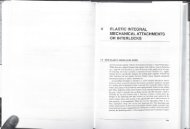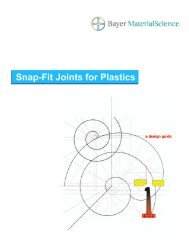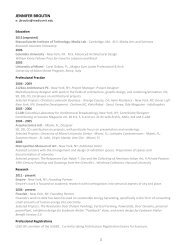Driven damped harmonic oscillator
Driven damped harmonic oscillator
Driven damped harmonic oscillator
You also want an ePaper? Increase the reach of your titles
YUMPU automatically turns print PDFs into web optimized ePapers that Google loves.
<strong>Driven</strong> <strong>damped</strong> <strong>harmonic</strong> <strong>oscillator</strong> <br />
Answer (a) <br />
Firstly, the motion will be un<strong>damped</strong> if there is no friction, i.e., there is no conversion of mechanical<br />
energy to heat.<br />
The motion will further be simple <strong>harmonic</strong> if the potential minimum can be well approximated by a<br />
parabola for small displacements.<br />
Specifically, suppose a particle at position is located in a potential field (). Suppose further that<br />
the potential minimum is at . Expanding the potential energy in a Taylor series about , we have<br />
() = ( ) + ( )( ) + 1 2 ( )( ) + <br />
Firstly, ( ) can be set to zero, since we are only interested in differences in potential energy.<br />
Secondly, since is a potential minimum, we have ( ) = 0 by definition (assuming () is<br />
continuously differentiable). So, defining = and = ( ), the above equation becomes<br />
() = 1 2 .<br />
This is exactly the equation for potential energy leading to simple <strong>harmonic</strong> motion.<br />
Answer (b) <br />
To solve the homogeneous equation<br />
we try a solution of the form<br />
+ + = 0<br />
() = exp .<br />
Inserting this into the homogeneous equation, factoring out exp and noting that exp 0 for<br />
any , we deduce a quadratic equation for <br />
with solutions<br />
+ + = 0<br />
= 4<br />
, <br />
2<br />
= + 4<br />
2<br />
Hence the homogeneous solution is a linear combination of the corresponding trial solutions<br />
where and are arbitrary constants.<br />
() = exp( ) + exp( ),
Answer (c) <br />
We are looking for a particular solution of the form<br />
() = () exp() (0.1)<br />
where () is the (complex) amplitude. Inserting this into the original equation (with the forcing<br />
term ) and solving for (), we obtain<br />
() =<br />
1<br />
+ + <br />
(0.2)<br />
The magnitude is defined as () = |()| and the phase as () = arg (). They can be<br />
plotted with the following Matlab code:<br />
omega=linspace(0.01,100,2001);<br />
m=1; k=1; gamma=0.1;<br />
H=1./(-m*omega.^2+1i*omega*gamma+k);<br />
figure(1)<br />
plot(omega,abs(H))<br />
set(gca,'XScale','log'); grid<br />
xlabel('\omega'); ylabel('G(\omega)')<br />
figure(2)<br />
plot(omega,angle(H))<br />
set(gca,'XScale','log','YTick',[-pi -pi/2 0]); grid<br />
xlabel('\omega'); ylabel('\phi(\omega)')<br />
This yields the figures below.
Figure 1 Amplitude response.<br />
Figure 2 Phase response.
Answer (d) <br />
To work out the first definition, we set<br />
Answer (e) <br />
Defining the Laplace transform of () as () and applying the standard theorems of Laplace<br />
transforms, (2.57) becomes<br />
[ () (0) (0)] + [() (0)] + () = 1<br />
.<br />
Using the initial conditions (0) = 0 and (0) = 0, we find<br />
() =<br />
1<br />
( )( + + ) . (0.3)<br />
The solution can then be found using inverse Laplace transformation. We have used the following<br />
Maple commands ( was replaced by , since is protected in Maple)<br />
><br />
><br />
The latter expression represents (), with replaced by .<br />
Answer (f) <br />
The lowest order correction is obtained by adding a term to the Taylor series expansion:<br />
() = ( ) + ( )( ) + 1 2 ( )( ) + 1 6 ( )( ) <br />
Using the results from (a) and defining ( ), we obtain<br />
The resulting force is<br />
() = 1 2 + 1 6 (0.4)
= <br />
= = 1 2 (0.5)<br />
The last term is the desired correction term. Using = 0 so that = , the modified forced<br />
<strong>damped</strong> <strong>oscillator</strong> equation becomes<br />
+ + + 1 2 = . (0.6)





